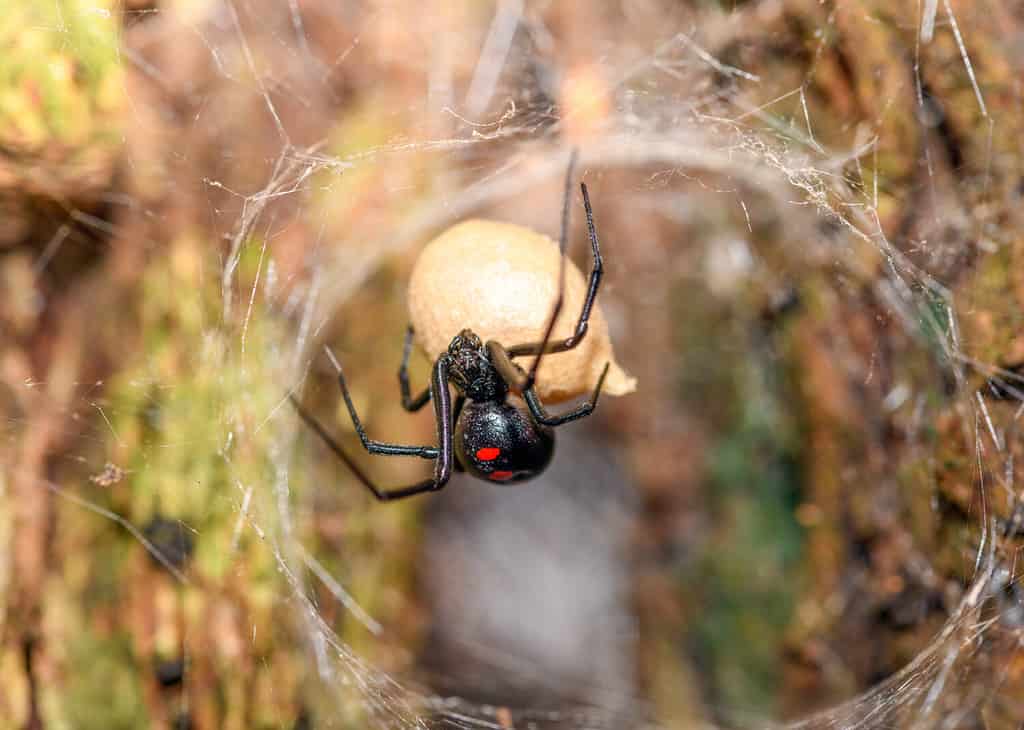Spiders are not everyone’s cup of tea, especially when it comes to the notorious black widow. However, learning about baby black widows might alleviate a smidge of arachnophobia. Below, you’ll find interesting facts about these young spiders, alongside pictures. Hopefully, our spider-fearing readers will gain a new perspective on these creatures.
1. Baby Black Widows Are Not Black

Spiderlings of the European black widow are reddish-brown with white spots.
©Frank Buchter/ via Getty Images
Young black widows cannot easily be identified if you’re looking for the telltale sleek black color and red hourglass on their abdomen. Additionally, only females mature to have this look. Male black widows tend to be brown. The markings of a black widow spider can vary based on their species, too! There are five North American species of black widow spiders. Only one has the infamous red hourglass: the southern black widow or Lactrodectus mactans. It is the most common species in North America but there are more than 30 species worldwide.
Young black widow spiderlings can be white, orange, or brown. They molt multiple times during their youth, gaining more color each time. Females can molt up to nine times before they reach their mature size.
2. Babies Stay in their Cocoon for Up to One Month

Female black widows protect their eggs aggressively.
©toddarbini/ via Getty Images
Egg sacs are usually laid in the late spring to summer months. Once a black widow lays her eggs (up to 300 in one egg sac) it takes about 20-30 days before the spiderlings start hatching. During this time, the mother spider protects the egg sac from predators and other spiders until her babies hatch.
After hatching, the spiderlings might linger on the web for a few days before they disperse to make their own web. Although they’re not full-grown upon departure, they’re capable of weaving a web to trap and consume prey until they’re mature enough to mate the following spring. Adult female black widows can live up to three years, whereas adult males hardly live past one year, often dying after mating.
3. Spiderlings Do Something Called “Ballooning”

Like adult black widows, spiders hang upside down to descend upon prey.
©Frank Buchter/ via Getty Images
Hatchlings “balloon” when they’re ready to leave the nest. This involves spinning silk into the air to be carried to new locations where they can set up shop. It’s called ballooning because spiders look like they’re attached to balloons, floating through the air. It might even look like the spiders are flying! This process is not unique to black widows. There are quite a few other spiders that use this technique, too.
Once in a new spot, away from competition from siblings, the spiderlings create their web to catch food for themselves. This web is where they’ll overwinter until they finish developing the next spring.
4. Juvenile Black Widows Are Not Dangerous

Adult black widows can inflict a nasty bite but it is hardly ever fatal to humans.
©Jeff W. Jarrett/Shutterstock.com
It may be unsettling to witness a black widow, let alone an egg sac or dozens of black widow spiderlings. However, these spiders are not very interested in humans. The most dangerous time for a human to come into contact with a black widow is when the mother is protecting her nest. Other times, any inflicted bites are accidental. For example, moving logs where a spider is hiding can startle it, forcing the spider to react.
Baby black widows and male adult black widows cannot bite humans. The only ones capable of biting and envenomating humans are adult females, who for the most part, can be avoided. However, it’s understandable if you’re not willing to wait around for the young to mature so you can tell if they’re female or male. Many people recommend vacuuming up the eggs to maintain a safe distance from the mother while also destroying the would-be children. However, this method can still be dangerous. If the spiders are not in an area where they’re bothering you, it might just be best to let them be. After all, black widows and other spiders are great for pest control!
5. Young Black Widows are Cannibalistic

Spiderlings overwinter in their web until they fully mature in the spring.
©Sari ONeal/Shutterstock.com
We’ve all heard that female black widows eat their partners right after mating. Fortunately, the mothers don’t turn on their young. Unfortunately, the same cannot be said for her children. Juveniles will occasionally eat their siblings for extra nutrition, just as adult females eat their mate to help provide them with the nutrients needed to lay the eggs.
The photo featured at the top of this post is © lighTTrace Studio/Shutterstock.com
Thank you for reading! Have some feedback for us? Contact the AZ Animals editorial team.






